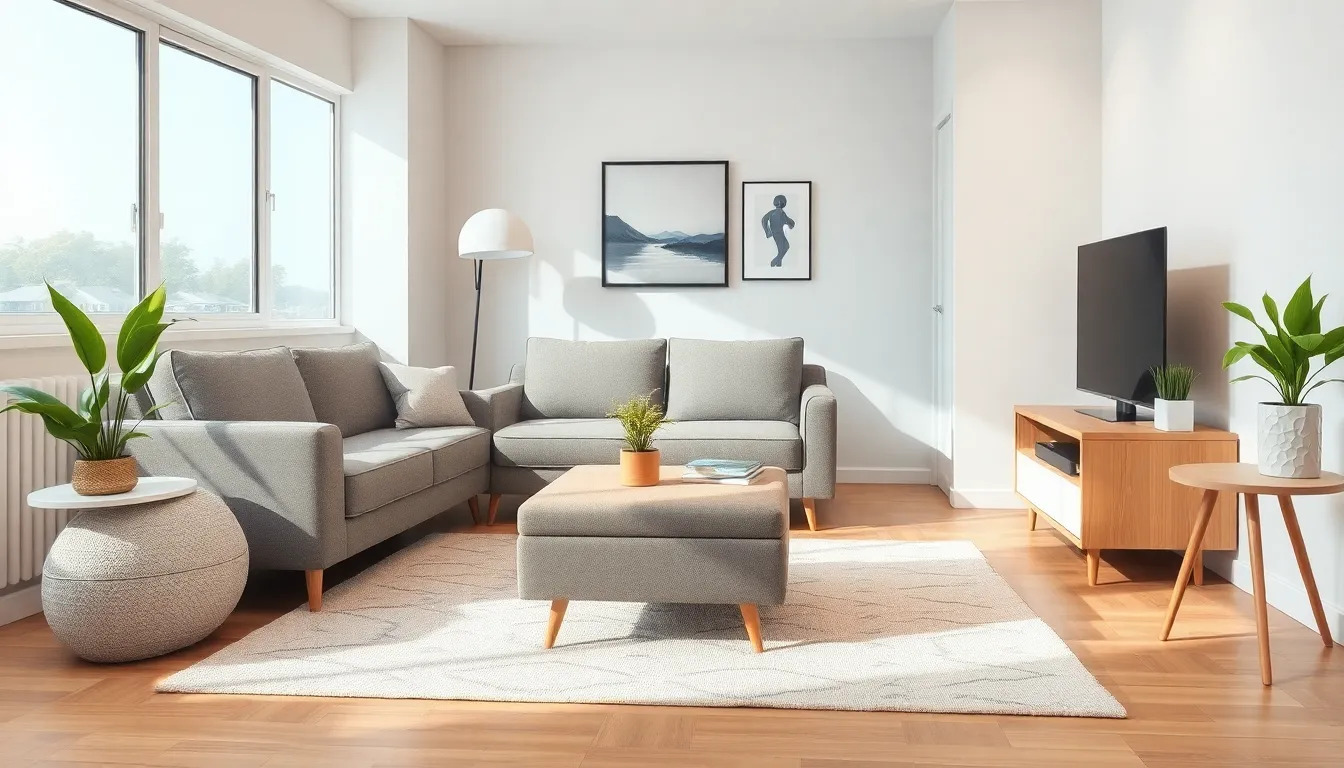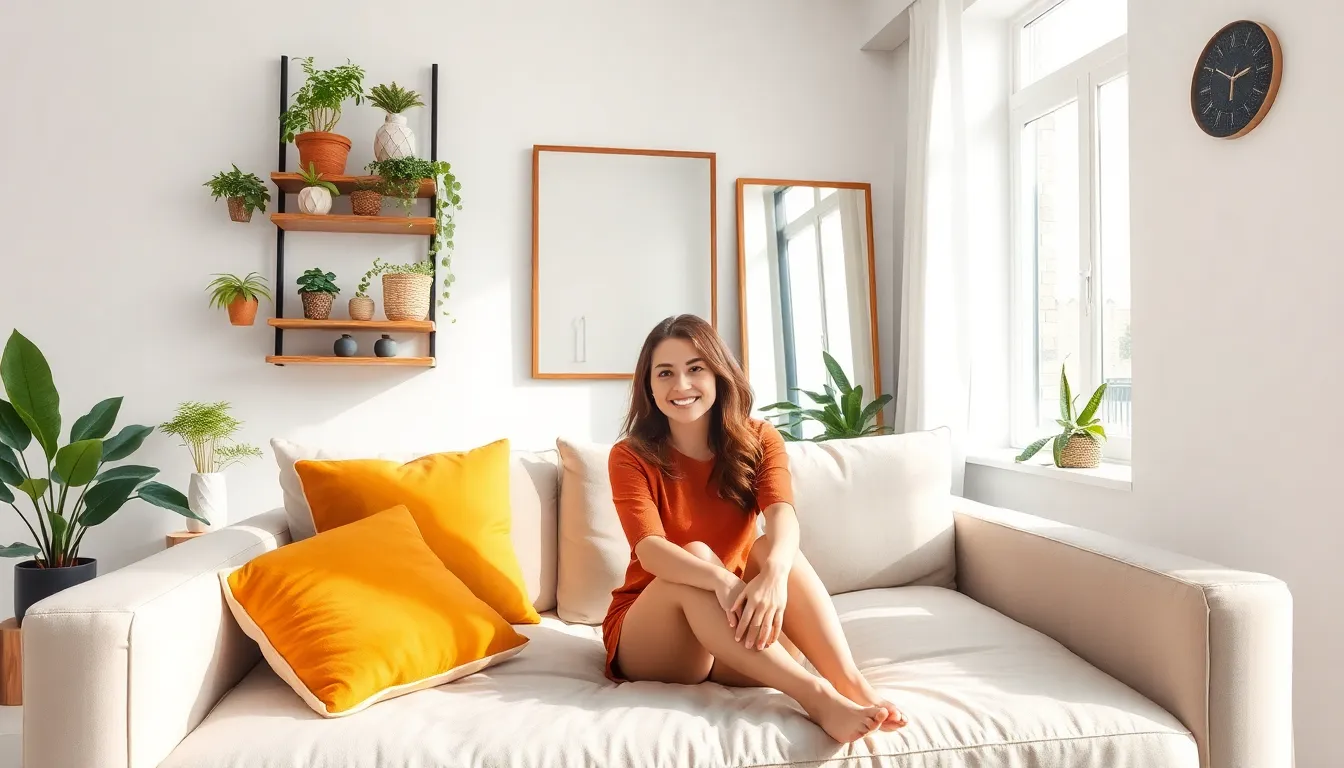Living in a small space doesn’t mean sacrificing style or comfort. In fact, it’s an opportunity to unleash creativity and transform even the tiniest nook into a cozy haven. With a sprinkle of ingenuity and a dash of flair, small spaces can become the envy of all your friends—who knew that a closet-sized living room could host epic game nights?
Table of Contents
ToggleKey Principles of Interior Design for Small Spaces
Small spaces require thoughtful design strategies. Focus on techniques that enhance functionality and aesthetic appeal.
Maximizing Light and Space
Natural light transforms small areas, creating an illusion of openness. Use sheer curtains or no window treatments to let in maximum sunlight. Mirrors reflect light and make rooms appear larger. A strategically placed mirror can double the visual space of a room. Avoid heavy furniture, which can make a space feel cramped; choose lightweight, multi-functional pieces instead. Opt for furniture that allows for storage or can be easily moved to create flexibility. Incorporate vertical storage solutions like shelves or tall cabinets to keep the floor area clear.
Choosing the Right Color Palette
Colors play a vital role in creating an inviting atmosphere. Light shades, such as whites or pastels, brighten a room and amplify the sense of space. An inviting atmosphere benefits from a cohesive color scheme; using a limited palette maintains visual harmony. Consider accent walls to introduce darker colors without overwhelming the area. Accessories in vibrant colors can add personality while keeping the overall look light. Neutral tones paired with colorful décor provide balance, ensuring the space feels welcoming and spacious. Select colors that reflect personal style while prioritizing airflow and brightness.
Furniture Selection and Arrangement

Furniture selection and arrangement play crucial roles in maximizing space in small areas. Choosing the right furniture creates a functional and stylish environment.
Multi-Functional Furniture
Multi-functional furniture offers versatility without sacrificing style. Sofa beds serve as seating during the day and transform into beds at night. Ottomans with storage provide extra seating and hide away clutter. Nesting tables allow for easy arrangement and can be tucked away when not in use. Selecting pieces that adapt to various needs ensures efficiency in smaller spaces, enhancing both comfort and utility. Prioritize items that blend aesthetics with functionality to create a cohesive look.
Optimal Furniture Layout
Optimal furniture layout enhances flow and accessibility within small spaces. Arranging furniture to create distinct areas helps delineate purpose without overwhelming the room. Placing larger pieces against walls maximizes floor space while allowing for circulation. Leaving a clear pathway aids movement and creates an open atmosphere. Using rugs can visually define different zones while maintaining cohesiveness. Aim for balanced arrangements that emphasize openness and make the space inviting for everyday use.
Storage Solutions
Effective storage solutions enhance small spaces by maximizing functionality. Creative approaches can transform cluttered areas into organized havens.
Creative Storage Ideas
Utilizing furniture pieces with built-in storage eliminates excess clutter. Consider ottomans that double as seating and hidden storage. Wall-mounted shelves provide a perfect spot for books and decorative items. Baskets placed on shelves or under tables add both style and practicality. Additionally, selecting multi-purpose coffee tables can offer hidden compartments for stashing everyday items. Always explore under-bed storage options for seasonal clothing or extra linens. These innovative choices create an aesthetically pleasing environment while keeping essentials accessible.
Utilizing Vertical Space
Maximizing vertical space encourages an efficient use of every available inch. Install tall bookshelves to draw the eye upward, giving the illusion of higher ceilings. Wall hooks can serve as storage for bags, hats, or accessories, freeing up floor space. Hanging planters not only beautify a small area but also utilize otherwise unused wall space. Consider mounting pots and pans for kitchen organization instead of occupying precious cabinet space. Prioritize storage units that stretch to the ceiling for optimal use. This strategy enhances both functionality and visual appeal, making small spaces feel larger and more inviting.
Decor Tips for Small Spaces
Decorating small spaces requires strategic choices to create a cohesive and inviting environment. Thoughtful decor can enhance functionality and improve overall aesthetics.
Mirrors and Reflections
Mirrors play a vital role in small space decor. They reflect light, which creates an illusion of openness. Placing mirrors across from windows maximizes natural light. Consider using large, framed mirrors as focal points. Wall-mounted options free up floor space while adding visual interest. Additionally, mirrored furniture can offer a stylish twist, contributing to a more spacious feel. Choosing reflective surfaces for decor items can also amplify brightness. Overall, incorporating mirrors effectively enhances the ambiance of compact spaces.
Incorporating Personal Touches
Personal touches bring warmth to small environments. Displaying unique decor items like travel souvenirs or handmade crafts adds character. Choose a few meaningful photos to create a gallery wall that reflects personal history. Using colors and textures that resonate will establish a comforting atmosphere. Additionally, incorporating plants brings liveliness and freshness. Opt for small indoor plants that fit well in limited spaces. These elements connect the occupant to the space, making it feel distinctly theirs. Prioritizing personal touches transforms small spaces into inviting retreats.
Transforming small spaces into stylish and functional areas is entirely achievable with the right approach. By embracing creativity and thoughtful design strategies, anyone can enhance their living environment. Prioritizing natural light and using mirrors effectively can create an airy feel while carefully selected furniture maximizes both style and space.
Incorporating multi-functional pieces and innovative storage solutions is essential for maintaining organization and openness. Personal touches through decor and greenery add warmth and character, making small spaces not just livable but truly inviting. With these principles in mind, small spaces can become beautiful retreats that reflect individual style and comfort.



